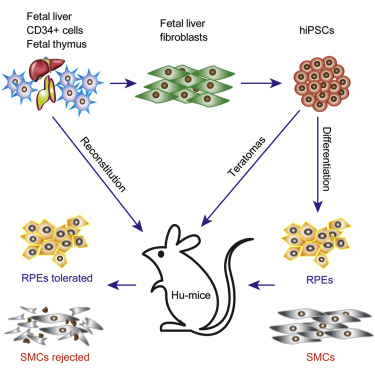Induced pluripotent stem cell (iPSC) technology has raised the possibility that patient-specific pluripotent stem cells may become a renewable source of a patient’s own cells for regenerative therapy without the concern of immune rejection. However, the immunogenicity of autologous human iPSC (hiPSC)-derived cells is not well understood.
Using a humanized mouse model (denoted Hu-mice) with a functional human immune system, Yang Xu and his colleagues from UC San Diego has shown that most teratomas or tumors formed by human iPSCs were readily recognized by immune cells and rejected. However, when these human iPSCs were differentiated into smooth muscle cells or retinal pigmented epithelial cells, the results were rather different. Human iPSC-derived smooth muscle cells appear to be highly immunogenic, but human iPSC-derived retinal pigment epithelial (RPE) cells are tolerated by the immune system, even when transplanted outside the eye.
When Xu and others examined these results more closely, they discovered that this differential immunogenicity is due to the abnormal expression of cell surface proteins in hiPSC-derived Smooth Muscle Cells, but not in hiPSC-derived RPEs.
These findings support the feasibility of developing hiPSC-derived RPEs for treating macular degeneration. They also show that iPSC lines must be individually screened to determine if their derivatives are recognized by the patient’s immune system as foreign.
These results were published in Cell Stem Cell.
